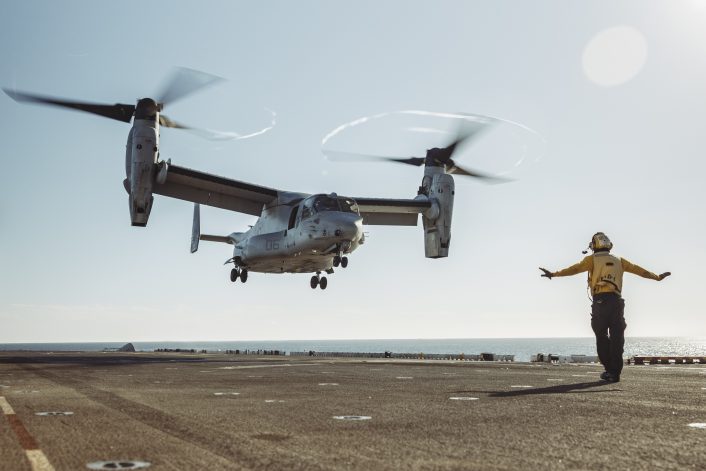The V-22s have been grounded for two weeks following a recent incident, however they are now returning to fly again after the inspection of the Proprotor Gearboxes.
The U.S. Air Force and Navy are finally resuming flight operations with the V-22 Osprey after the latest grounding which followed a recent incident. However, the Naval Air Systems Command (NAVAIR) has directed the services to perform new inspections on each tiltrotor before its next flight.
In fact, NAVAIR has issued a fleet bulletin directing the inspection of the V-22 to verify the flight hours on each Proprotor Gearbox (PRGB). If the PRGBs installed on the aircraft both meet or exceed a predetermined flight-hour threshold, then the Osprey can resume flights in accordance with controls instituted in the March 2024 interim flight clearance (IFC), said NAVAIR in a statement.
The command has also put in place additional risk mitigation controls with a new IFC which has been issued to address aircraft with PRGBs below the flight-hour threshold. These controls, says NAVAIR, will remain in place until the aircraft’s PRGBs are upgraded, or the predetermined threshold is exceeded.
NAVAIR collaborated with the Navy, Air Force Special Operations Command and the Marine Corps to implement the bulletin and IFC, although the latter resumed flying the Osprey even before the new bulletin was issued.

New restrictions
It appears that the threshold set by NAVAIR, which has not been released due to operational security concerns, is a minimum flight hours requirement to be considered “safe.” In fact, as mentioned by Air Force Special Operations Command Spokeswoman Lt. Col. Becky Heyse to Defense News, if the gearbox is found to have fewer flight hours than the threshold, the Osprey will have to fly under a new and stricter set of limitations.
Similarly, Japan’s Ministry of Defense said that it has been informed that the results of an analysis recently conducted by the U.S. suggested the potential for malfunctions to occur in PRGBs that have not yet reached a certain flight time. Japan will resume operations similarly to the U.S. operators of the Osprey.
The possible reason was reported by Flight Global, which mentioned that “The metallurgical weakness within the V-22 transmission is thought to manifest itself relatively early in the component’s lifespan, meaning PRGBs with flight hours above the threshold have been deemed safe.”

The latest grounding
NAVAIR called for an operational pause on Dec. 6, 2024, after an Osprey performed a precautionary landing due to an engine failure. NAVAIR recommended the operational pause “out of an abundance of caution” based on the initial investigation.
“The safety of our V-22 aircrew is our top priority. We are committed to ensuring our Sailors, Airmen and Marines are able to successfully complete their missions and return home safely,” NAVAIR said. The command also added that it “remains committed to transparency and safety regarding all V-22 operations.”
The incident which prompted the pause involved an Air Force Special Operations Command (AFSOC) CV-22 and happened at Cannon Air Force Base, New Mexico, on Nov. 20. According to the Associated Press, the incident presents similarities to the crash off the coast of Japan in November of last year, and the measures adopted after it allowed to save lives.
In fact, it is being reported that the CV-22’s received similar warnings in the cockpit shortly after takeoff and subsequently lost an engine. The crew was able to quickly perform a safe landing and put the tiltrotor on the ground.
The initial investigation found that metal parts broke and shown metal weaknesses similar to the one found in the Osprey crashed in Japan. The unspecified part that failed, however, was reported to be different than the Prop Rotor Gear Box. However, the NAVAIR has now asked for new inspections of the PRGB, so it might still have something to do with the failure.

The recent troubles
Previous accidents involving the Osprey were attributed to a recurring “hard clutch engagement,” a result of a design flaw in the component. However, in the November 2023 crash, investigators pointed to the gearbox as the cause in their preliminary findings.
The tilt-rotor CV-22 has a prop-rotor gearbox in each engine nacelle which transmits power from the engine to the proprotor and reduces the speed of the shaft. The catastrophic failure was located in the Osprey’s left-hand PRGB, where a crack high-speed pinion gear caused it to fail, breaking apart and causing an onset of rapidly cascading malfunctions.
This resulting “instantaneous asymmetric lift condition” was unrecoverable by the mishap crew. The crew received three “PRGB CHIP BURN” alerts on the CDU screen, followed by a “L PRGB CHIPS” flash. This meant the chip detectors found pieces of metal that couldn’t be burnt off.
In October 2024, an independent investigation by Hunterbrook has narrowed down poor manufacturing processes and inadequate quality control as the causes of the catastrophic failure in the PRGB. These issues were traced back to Universal Stainless, the manufacturer of the alloy used in the gear that failed on the ill-fated Osprey.
A month later, few days after the incident which prompted the latest grounding, the Associated Press reported that lawmakers sent a letter to Defense Secretary Lloyd Austin asking him to re-ground the military’s entire fleet of V-22 Ospreys until solutions can be put in place to address safety and design issues. The letter said that “given the current concerns about the safety of the V-22, the aircraft should be grounded, and should not be deployed again until the platform’s significant deficiencies are fully addressed.”








